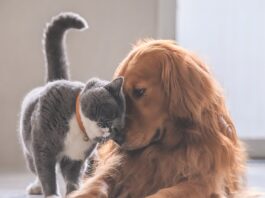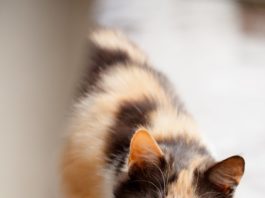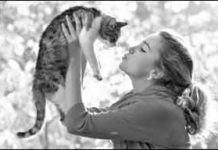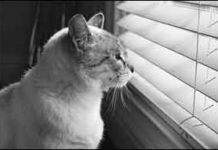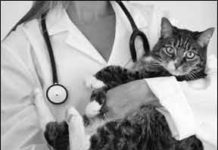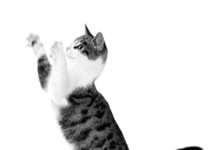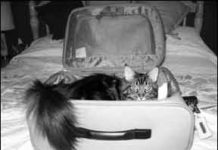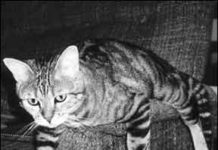Smart Tactics to Stop Destructive Chewing
Pipper loved to lick plastic and crawled eagerly into every plastic bag she could find. But the longhaired black cat’s fascination with plastic eventually progressed to a big problem — chewing the plastic and ingesting tiny pieces to the alarm of her owner, Pamela Perry, DVM, Ph.D., a lecturer in animal behavior at the Cornell University College of Veterinary Medicine. While some dogs chew sundry objects from shoes to sofa legs, cats tend to focus on houseplants, thread, string, yarn and electrical cords. Some, though, like Pipper, chew plastic, and Dr. Perry reached a turning point with the threat to her cat’s health. Ingested plastic could lead to an intestinal blockage. “I had to make sure that all plastic bags were put away,” she says. “They had to be well-hidden or she would find a way to get them.”
Short Takes: April 2013
A survey of more than 50,000 U.S. households has uncovered a puzzling disconnect between cat owners’ beliefs and actions. Owners in 2011 said they increasingly consider their cats family members — 56 percent, up from 49.4 percent in 2006. Yet just 27.1 percent of owners say they took their cats to the veterinarian only when they were sick. Given that the feline population in the U.S. is approximately 74.1 million, about 20 million pet cats went without regular checkups and care in 2011.
New Options for Separation Anxiety
Collars and diffusers that dispense calming pheromones have become popular among owners eager to ease their catsf separation anxiety. Less generally known but promising new options are supplements and specialized diets. gThe area of veterinary nutraceuticals to treat anxiety is becoming quite active,h says Katherine A. Houpt, VMD, Ph.D., former president of the American College of Veterinary Behaviorists and James Law Professor emeritus of Animal Behavior at the Cornell University College of Veterinary Medicine. gDietary supplements with ingredients like green tea, as well as flower essences like Harmonease, are also now available.h
When You Want to Adopt a Stray
Your next cat may show up when you least expect it. You glance out the window and see a skinny cat with a dirt-smudged coat looking back at you. He doesn’t rush to greet you like a lovable, lost Labrador Retriever. He sizes you up, determining if you’re friend or foe. You place bowls of food and water on the back porch to prevent him from starving or becoming dehydrated, but as the days pass and the cat moves closer to you and lets you pet him, you’re smitten. You’ve made the transition from performing an act of kindness to wanting to provide a safe, loving home.
Ask Elizabeth: February 2013
As you know, we cats are very sensitive creatures, but in your case, as with other cats with feline hypersensitivity syndrome (FHS), this sensitivity seems to be ratcheted up to varying degrees. FHS is a recognized syndrome in the feline world, although the definitive cause is not clear at this time. While it is not, in and of itself, believed to be serious with respect to its effect on overall health or longevity, a few important points regarding this unusual behavioral syndrome are worth making, especially for our human friends who are commonly puzzled by its manifestations. FHS, also variably referred to as rolling skin syndrome and atypical neurodermatitis, is characterized by dramatic twitching or rippling of the skin, most commonly on the back between the middle of the spine and the base of the tail or in the flank region, with intermittent jerking of the body and exaggerated tail movements.
They Jump, Paw, Cry, Stare and Meow
Considering that kittens vocalize to their mothers for everything they want, it’s not unusual for cats to meow or beg for food and attention from their owners. In cat-owning households, humans are the mother cats.
In The News: The mysterious purr eludes translation
Conventional wisdom has long held that purring is a sign of contentment, a cat purring on a sunny windowsill by the owner’s side being a perfect example. However, researchers have found that cats also purr in other, often surprising situations — when giving birth and nursing, when under duress and even when dying.
Ask Elizabeth: August 2012
I have been purring nearly my whole life so I should be an expert! However, like many feline characteristics, purring is mysterious — even to me! Let me share what my friends at the Cornell Feline Health Center have to say about purring. At its core, purring is a means of communication — but cats purr in a variety of situations: when they are comfortable and content, of course, but also when they are anxious, injured or ill. What, exactly, a cat is communicating in these various situations is open to interpretation. The most straightforward purring is done by baby kittens. Starting at about two days of age, kittens purr in the presence of their mother, and in response to nursing. This early purring is likely to be an ‘I’m OK’ signal to the queen, and along with kneading movement of the front paws on the mammary gland area, may serve as a stimulus for milk letdown.
A Commitment to Improving Well-being
Imagine veterinarians being able to sterilize feral cats by vaccination instead of surgery. Or to identify the connection between a relatively benign form of feline coronavirus and feline infectious peritonitis, which is nearly always fatal, with the hope of finding ways to diagnose and combat it. Or discover how and why vaccine-associated sarcomas may trigger DNA damage in some cats and how this damage may be used to predict which cases of the sarcomas are amenable to chemotherapy. These are just three of the many scientific studies funded by the Cornell Feline Health Center where, under the guidance of Director Colin Parrish, Ph.D., Professor of Virology, the goal of bettering the health of cats continues to be the focus and commitment, as it has been since the center opened its doors in 1974.
Ask Elizabeth: June 2012
Aromatherapy, for readers who may not be acquainted with the term, is the practice of releasing the essences of various botanicals into the air for beneficial effects. Some essences are utilized as a form of alternative medicine and are said to ease pain, diminish inflammation, fight infection and reduce stress, among other things. Other essences are used, as is the case for you and your wife, for aesthetic purposes because they smell good. While the medicinal value of aromatherapy is debatable (and contested by some medical experts), there is no doubt that any household can get a pleasant boost from such delightful fragrances.
Cats and Separation Anxiety
Vacations are wonderful, but there’s nothing like home sweet home. You drive home from the airport, excited at the thought of sleeping in your own bed, and seeing your beloved cat. And she does seem happy to see you at first, and you greet each other and cuddle several times. Then you go off to unpack …. and there she goes — right into your suitcase, urinating all over your folded clothes. To you, it may feel like your cat is angry because you left her — and this is the way she’s making her feelings known. But can a cat really hold a grudge?
How to Curb Destructive Scratching
Just days after youve invested in new furniture, your cat decides she really loves it, too. Its the place shes chosen to give herself a pedicure, and soon the arms of that beautiful new sofa look like theyve gone through a shredder. You may notice your cat flexing her nails when she first gets up and stretches or suddenly stop to sink her nails into the wall-to-wall carpeting as she crosses a room. She may scratch at the end of a burst of energy after playing with her favorite toy. Fabrics, carpet, wood, cardboard - there are numerous materials in your house that can soon become a target for your cats clawing.



